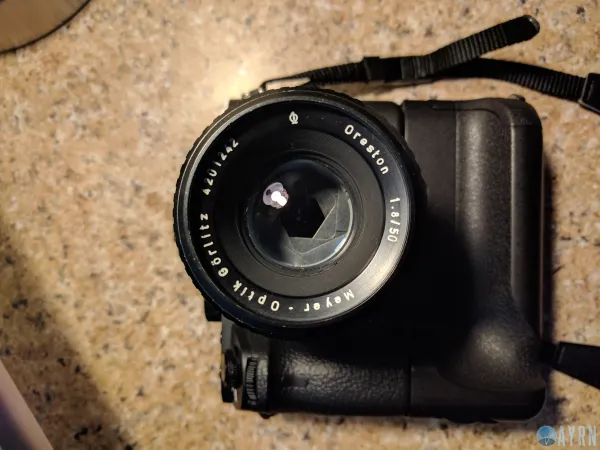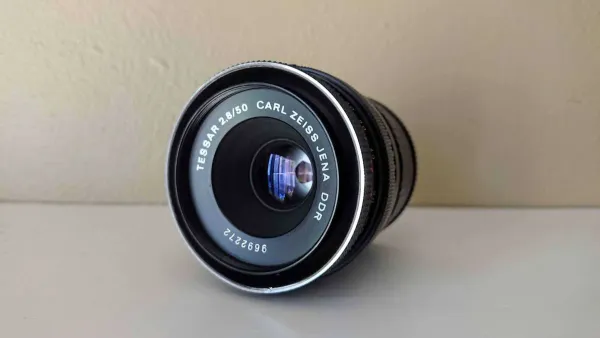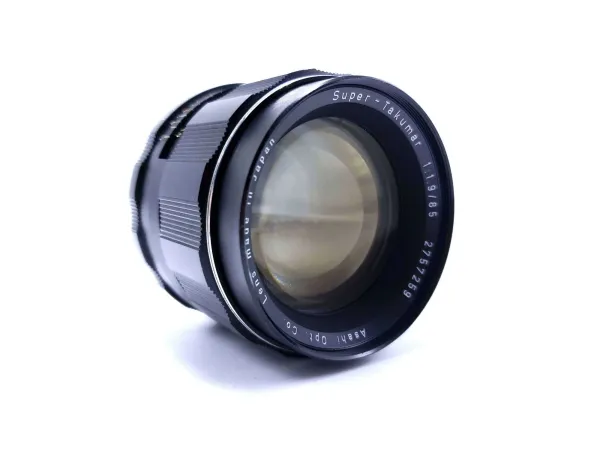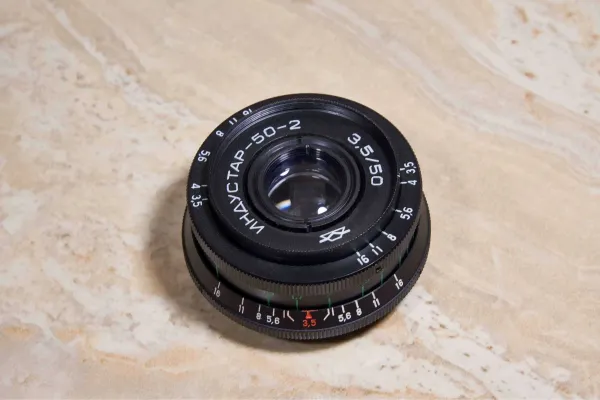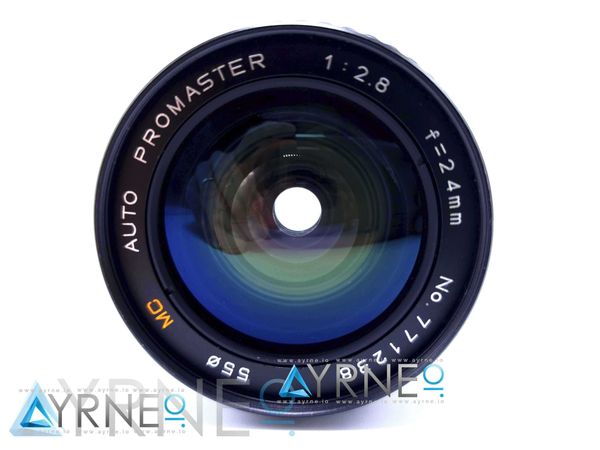First Impressions
The Rubinar 500mm f/5.6 is one of those lenses that, at first glance, immediately transports you back to an era of robust, no-nonsense Soviet engineering. When you first handle this lens, its hefty build and utilitarian design make it clear that this isn’t just a piece of glass—it’s a tool designed for serious, long-range photography. Unlike modern telephoto lenses that emphasize portability, the Rubinar 500mm is all about stability and reach.
Unboxing the lens, you'll notice its solid metal construction, which gives it a reassuring weight and durability. The focusing ring is generously sized and offers a smooth but deliberate action, allowing for precise adjustments, which is crucial at such a long focal length. The lens also comes with a built-in lens hood, a thoughtful feature that helps reduce flare and protect the front element. Everything about this lens feels purpose-built, from the thick metal barrel to the sturdy tripod mount, indicating that it was designed to withstand the rigors of fieldwork.
Specifications
| Specification | Details |
|---|---|
| Model | Rubinar 500mm f/5.6 |
| Type | Mirror Telephoto |
| Focal length | 500mm |
| Focal format | Full-frame / 35mm |
| Max aperture | f/5.6 |
| Min aperture | Fixed at f/5.6 |
| Angle of view | 5° |
| Optical formula | 6 Elements in 5 Groups |
| Minimum focal dist. | 4m (13.1ft) |
| Filter thread size | 77mm (front) / 33mm (rear) |
| Lens hood | Built-in |
| Mount type | M42 Screw Mount |
Features
| Feature | Details |
|---|---|
| Focus ring | Manual |
| Autofocus | No |
| Image stabilization | No |
| Optical coating(s) | Multi-coated |
| Front element rotation | No |
| Internal focusing | No |
| Lens extension while focusing | Yes |
| Aperture ring | Fixed aperture at f/5.6 |
| De-clickable aperture | N/A |
| Architecture | Mirror lens |
History and Background
The Rubinar 500mm f/5.6 was produced by the Lytkarino Optical Glass Factory (LZOS), a prominent Soviet manufacturer known for creating high-quality optical instruments, including military-grade lenses. This particular lens belongs to the Rubinar series, which is well-regarded for its catadioptric, or "mirror," lenses. These lenses are characterized by their ability to achieve long focal lengths in a relatively compact and lightweight package, thanks to the use of mirrors to fold the optical path.
The Rubinar 500mm f/5.6 was developed during the latter half of the 20th century, during a time when the Soviet Union was producing some of its most iconic and durable optics. This lens was designed for photographers who needed to capture distant subjects with clarity and detail, whether for wildlife photography, sports, or even astrophotography. The mirror lens design, with its fixed f/5.6 aperture, allows for a unique balance between image brightness and depth of field control.
Image Quality
When it comes to image quality, the Rubinar 500mm f/5.6 delivers a performance that is distinctively different from that of conventional refractive lenses. The mirror design means that the lens produces sharp images with minimal chromatic aberration, as the mirrors do not disperse light in the same way glass elements do. This results in images that are crisp, particularly in the center of the frame.
However, as with most mirror lenses, the Rubinar 500mm has some quirks. The out-of-focus areas exhibit the characteristic donut-shaped bokeh, which can be a love-it-or-hate-it feature depending on your aesthetic preferences. Additionally, the fixed f/5.6 aperture means that you’re somewhat limited in terms of depth of field control, and the lens performs best in bright conditions where you can maintain a fast enough shutter speed.
Sharpness
The Rubinar 500mm f/5.6 is capable of delivering sharp images, especially when used with a stable tripod and careful focusing. Center sharpness is excellent, which is where this lens shines the most. Edge sharpness, however, can be a bit softer, particularly at longer distances. This isn’t necessarily a deal-breaker, but it does mean that you’ll need to be mindful of your composition and ensure your subject is within the sharper central area of the frame.
Bokeh
The bokeh on the Rubinar 500mm f/5.6 is one of its most unique features. Due to its mirror design, out-of-focus highlights take on a distinctive donut shape. This can be a fun and creative element to play with, especially if you’re looking to add a surreal or abstract quality to your images. However, if you’re after the smooth, creamy bokeh of traditional lenses, this might not be the look for you.
Build Quality
In terms of build quality, the Rubinar 500mm f/5.6 is built like a tank. The all-metal construction gives it a rugged, durable feel that is perfect for outdoor use in challenging conditions. The focusing ring is well-damped, providing just the right amount of resistance to make fine adjustments easy, yet precise. The lens hood is built-in, which is a practical feature that adds to the lens’s durability and helps reduce flare when shooting in bright light.
The overall design is simple and straightforward, with no unnecessary frills—just solid, reliable construction. This lens is clearly made to last, which is a testament to the Soviet engineering ethos of the time.
Manual Focus Performance
Manual focusing with the Rubinar 500mm f/5.6 is a deliberate process. The long focus throw allows for precise adjustments, which is essential for a lens of this focal length. Given the fixed aperture and long reach, it’s important to take your time with focusing, especially when shooting at greater distances. The lack of autofocus isn’t an issue if you’re used to manual lenses, and the Rubinar rewards careful focusing with sharp, detailed images.
Feature Breakdown
The Rubinar 500mm f/5.6 is a specialized lens that prioritizes telephoto reach and optical performance over modern conveniences. It doesn’t have autofocus, image stabilization, or a variable aperture, but it does offer a unique combination of compact design and long focal length that’s hard to find in other lenses.
The mirror lens design is both an asset and a challenge—it allows for a relatively lightweight build, but it also introduces the characteristic donut bokeh and fixed aperture. This makes the Rubinar 500mm f/5.6 a lens best suited for photographers who understand its quirks and know how to leverage its strengths.
Pricing and Availability
On the second-hand market, the Rubinar 500mm f/5.6 typically sells for around $200 to $400, depending on the condition and whether it includes original accessories like the case, caps, and filters. Considering its unique capabilities and build quality, this lens offers good value for photographers looking for an affordable way to explore long-range photography.
As with all vintage lenses, availability can vary, so it’s worth keeping an eye on auctions and photography gear websites if you’re in the market for one.
Conclusion
The Rubinar 500mm f/5.6 is not your average telephoto lens—it’s a piece of photographic history that offers a unique shooting experience. With its solid build, distinctive image rendering, and long reach, it’s a lens that stands out in a world of modern, plastic alternatives.
While it may require a bit more patience and skill to use effectively, the results can be highly rewarding for those who appreciate the art of manual photography. Whether you’re shooting wildlife, sports, or even celestial bodies, the Rubinar 500mm f/5.6 provides a level of optical performance that is both intriguing and satisfying. If you’re looking for a telephoto lens with character, this Soviet-era gem is definitely worth considering.


